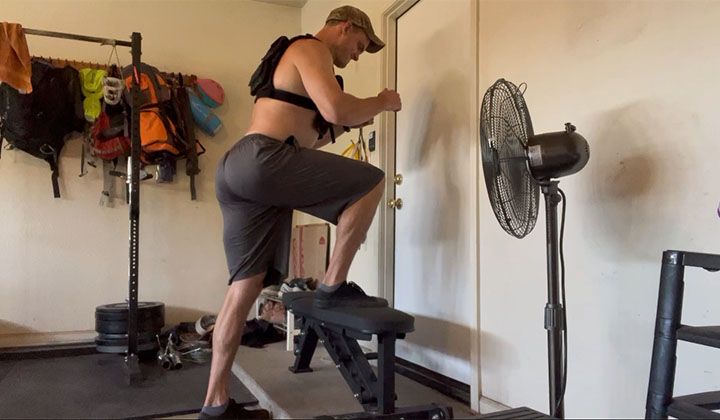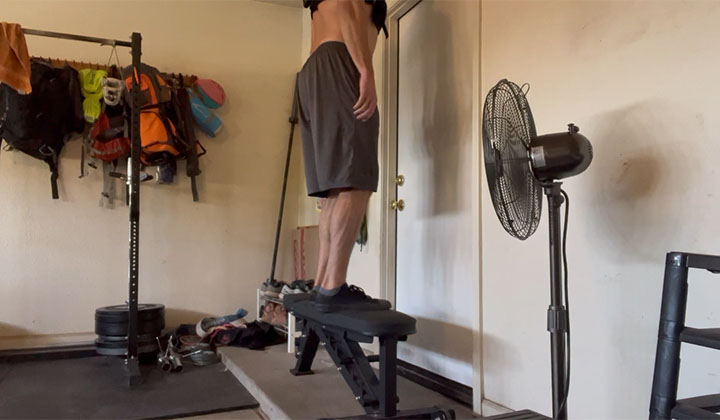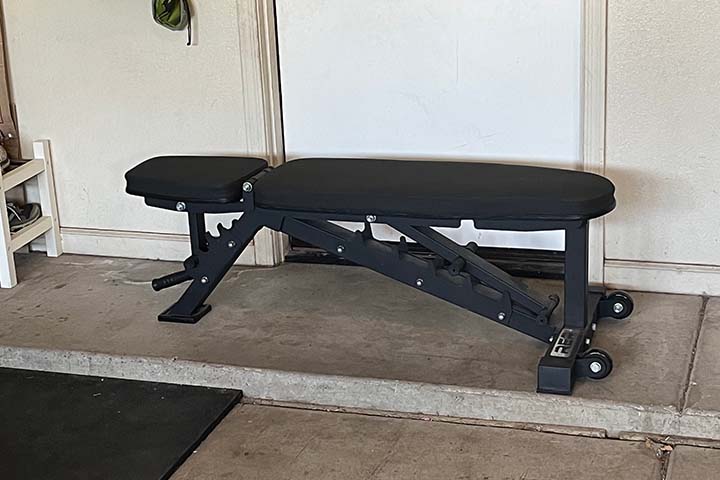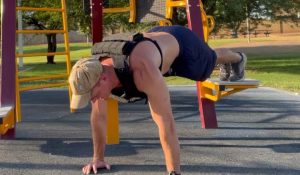Despite my obsession with micro-workouts and efficiency in training sessions, I’m also known to be a bit of glutton for punishment.
Whenever I bring up this brutal session in conversation, the question inevitably comes up: how on Earth do you actually train for the Chad 1000X?
I’ve found it very useful to dedicate a day per week to training specifically for Chad 1000X in the weeks leading up to Veteran’s Day, while utilizing other days of the week to support this single, strenuous workout day and maintain other dimensions of fitness.
What follows is the specific plan I’ve used in the past to get ready to complete the Chad 1000X workout on Veteran’s Day. However, since this Hero WOD seems to get significantly less exposure than the more well-known Murph Challenge, I’ll first discuss what the WOD is, and how to do it:
How to do the Chad 1000X WOD
The Chad WOD is deceptively simple. It’s only one movement:
- 1000 step-ups to a 20” box
- Wear a 45lb ruck (men), or a 35lb ruck (women)
The humble step-up. But there’s a catch. The step-ups are weighted (45lb ruck for men, 35lb ruck for women), and to a 20-inch box).
And, as the name suggests, there’s 1000 of them.
Most individuals will find this is a higher box than they are used to doing step-ups on, and using more weight than they are used to for normal step-ups.
As in any other notoriously difficult Hero WOD, there’s no shame in starting slick (no rucksack), or exercising creative license when you pick the height of your box.
However, for the purposes of this article, we’ll be assuming you’re planning to scale up to the expert version (Rx).
The point of Chad (and Hero WOD’s in general)

One note before we continue:
If you’re training for Chad, completing Chad, or looking forward to Chad, make sure not to forget the point of this Hero WOD: to honor Chad Wilkinson and to bring awareness to the epidemic of suicide among our veterans.
I point this out because I think it’s easy to get focused on the workout and forget the point. The workout is hard on purpose, and it’s intended to raise awareness for suicide prevention in veterans.
If you can, take this opportunity to donate to the Navy Seal Foundation or other veteran mental health initiatives.
That being said, let’s discuss how to actually tackle what I’ve heard termed the “toughest CrossFit WOD in existence.”
The challenge with Chad 1000X Training
One thing I’ve noticed in the past when I’ve been working up to doing the Chad 1000X event is that, more so than other notoriously brutal high-rep WODs (looking at you, Murph), the Chad tends to wear on my joints.
There’s something about single movement WODs that’s just a killer. If you’ve ever made a full session out of weighted vest squats or lunges, you’re very familiar with this concept. Not to mention that I can’t think of a single other WOD where we’re working up into the quad digits of repetitions.
Especially when my training sessions get above 300-500 continuous repetitions of weighted step-ups, I find that my legs and knees sometimes get so fatigued that I’ll get twinges of knee pain throughout the week.
Therefore, making recovery between sessions a top priority is part-and-parcel to being successful on this plan.
The solution: one day per week Chad-specific sessions
To solve the problem of the potential overuse injuries, I tend to focus one specific day of the week on Chad-specific training when I’m trying to build up to this session.
Note that this does not mean only training once per week. It simply means that the high-rep step-up training is limited to once per week so that I’ve got adequate recovery resources allocated for other exercises that will support my goals while keeping me healthy.
Of course, your mileage may vary on this. Feel free to experiment with higher frequency if you wish, but you’ve been warned!
What follows is the exact routine I follow when I’m working up to this beast of a WOD.
Monday: The Chad-specific training session


Though there are many ways to skin this cat, I submit to you that in general, high-specificity training is usually best, when possible.
Generalist training is great, but not during this season. Right now we’re training for something highly specific, and our training ought to reflect that.
If we’re training to complete Chad, then we ought to be engaging in the kind of thing we’ll have to be doing during the Chad session: high-repetition weighted step-ups!
For this reason, my Chad-specific training session is boringly simple and focuses on building muscular endurance. I look at Chad 1000X training as being similar to the “long run” day in marathon training. That is to say that week after week, we’re going to push the volume slightly to adapt our bodies and minds to the kind of demands we’ll be under on “race” day.
For all sets of step-ups below, use the correct box height and vest weight that you’ll be using on Veteran’s Day. Also, rest 3-4 minutes between training sets:
- Week 1: Two sets of 50 step-ups (100 total)
- Week 2: Two sets of 100 step-ups (200 total)
- Week 3: Three sets of 100 step-ups (300 total)
- Week 4: Two sets of 150 step-ups, one set of 100 step-ups (400 total)
- Week 5: One set of 200 step-ups, two sets of 150 step-ups (500 total)
- Week 6: Three sets of 200 step-ups (600 total)
- Week 7: Three sets of 200 step-ups, one set of 100 step-ups (700 total)
- Week 8: Four sets of 200 step-ups (800 total)
- Week 9: Take the week off and deload, you crazy bastard!
- Week 10: Veteran’s Day – complete Chad 1000X.
If you start this plan during the first week of September, you should be hitting your deload week the week before Veteran’s Day. Lucky you, the weather will be cooling off as the weeks go by, as well!
Friday: The leg strength session
As mentioned above, I like to keep a leg strength session in my week when I’m training for high-rep work like Chad. I purposefully place it on the opposite end of the week from the high volume step-ups because that allows for maximum recovery between lower body sessions.
I find that this approach of keeping a strength session at the end of the week has a few benefits:
- It provides an opposite end stimulus from the high-rep work which doesn’t interfere with the endurance stimulus from Monday’s workout
- It makes the high-rep work feel easier by comparison
That being said, I tend to structure this session as follows, using basic barbell exercises:
- Barbell back squat variation of choice: Over 5-6 sets, work up to a moderately heavy triple, leaving approximately 3 reps in reserve.
- Barbell deadlift variation of choice: Over 5-6 sets, work up to a moderately heavy triple, leaving approximately 3 reps in reserve.
That’s it! Allow yourself to fully recover between exercises – there’s no cardio and no time limits here. Just good old fashioned heavy weights. Each exercise should take you about 10-12 minutes.
A word of caution – remember that this session is intended to supplement Monday’s work. Resist the urge to go to 1 RIR or muscular failure or you’ll likely run into recovery issues as you enter week 5-6 and above.
Putting it all together: the weekly Chad 1000X training plan
The way I structure my training when I’m training for Chad is by placing high-repetition (and high-specificity) step-up work on one end of the week, and then low-rep strength work at the other end of the week.
- Monday: “Chad” training (details on this session below)
- Tuesday: Upper body myo-reps (weighted push-ups, weighted pull-ups, curls)
- Wednesday: Off
- Thursday: Upper body myo-reps (weighted dips, weighted inverted rows, curls)
- Friday: Squats & deadlifts (lower body strength work
- Saturday & Sunday: Off (or easy jogging or hiking)
You’ll notice that this is a modification of the traditional upper/lower split. In a normal upper/lower split, you’d alternate your sessions: upper, lower, off, upper, lower, off, etc.
In this modified version, I’ve altered the order to place the highest number of recovery days after Monday’s session (which should be the most strenuous session of the week): lower, upper, off, upper, lower, off.
Additionally, I’m deliberately using myo reps on my upper body days because I’m purposely putting upper body work on the back burner. Of course you’re welcome to utilize whatever 2-day upper body lifting sessions you wish here. I simply structure it this way because it allows me to focus on what I’m actually building towards: finishing Chad.
Potential modifications to the plan

4-week or 6-week Chad training plans
While the program above is really 8 weeks of training followed by a deload, the plan could easily compressed into a shorter time-frame by increasing the number of step-ups you’re adding session-to-session. For instance, you could do:
- Week 1: 2×100 step-ups
- Week 2: 2×200 step-ups
- Week 3: 2×200, 2×100 step-ups
- Week 4: 4×200 step-ups
- Week 5: Deload
One word of caution, however. I would advise you to only attempt a “compressed” training program such as the above if you know you’re already in very good shape and accustomed to high-rep weighted calisthenics.
I say this because you’re essentially adding 200 repetitions per session – not for the faint of heart. Also be aware that part of the 10-week build up is allowing us to build cardiovascular fitness specific to this challenge. If you cut the time frame in half, you’ll experience less of the benefits by definition.
That being said, you’re welcome to attempt the plan above.
Longer build-up (16-20 week Chad training plan)
The first time I built up to Chad, I actually took quite a bit longer to build up. Now that I’ve done it before, I no longer spend the full 20 weeks. However, if you’re new to step-ups, or you just want to spread the load over a longer time horizon (I can guarantee you’ll see better overall fitness results this way as well), then you’re welcome to add “half-steps” between the 10 weeks in the plan above.
Simply start week one by performing a single set of 50. Then in subsequent weeks add 50 step-ups per session until you reach approximately 800.
Why are we only building up to 800 repetitions? Why not 1000?
This is a common question I get when folks ask me how I prepare for Chad. My answer to this question is always the same:
Like a marathon runner, we don’t need to actually complete the distance of the race in training, we simply need to prepare our bodies to handle the volume of the final event. Once you hit around 800 repetitions in training, I’d say you’re prepared to take on the challenge.
Of course, your mileage may vary. Perhaps you need to build to 900 repetitions in training in order to feel mentally ready for the challenge. There’s nothing wrong with that; you’ll just need to adjust your training plan accordingly to account for that.
Similarly, if you’re someone who feels prepared once you can do 500-600 repetitions in training, then have at it. Nobody’s going to say you can’t do it this way.
However, in my experience, 800 repetitions in training is a good solid number to reach, which means we’re prepared to take on the full 1000 repetitions.
Some equipment hacks

Before we wrap things up, Here are a couple of things that could make your life easier as you’re training, since we don’t always have control over the height of the step-up boxes we have access to, and many of us don’t have rucksacks:
- A traditional bench press bench is 17″ in height. If you don’t have a 20″ box for step-ups, simply place a bench on some bumper plates and you should be in the neighborhood of 20 inches.
- Since some of us don’t have a rucksack for training, I’ve had good luck using a simple ingot-style weight vest (V-Max) and loading it up to 45 pounds. However, you could just as easily hold a 20-25lb dumbbell in each hand, or simply put a pile of 10lb plates in a normal backpack or hiking bag you’ve got laying around.





















